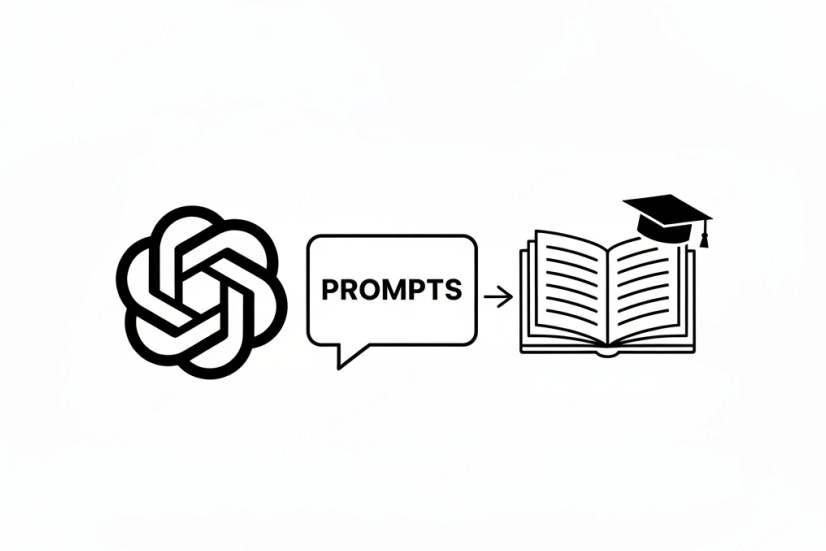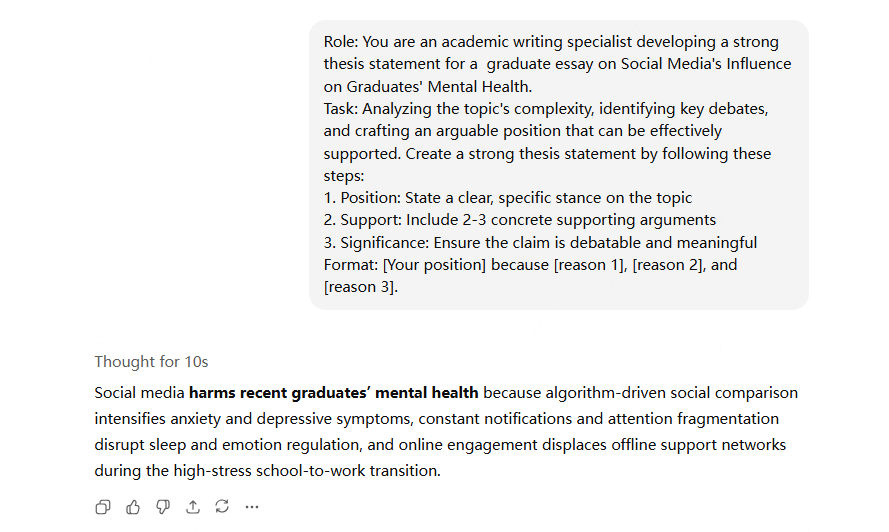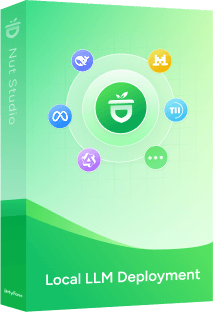
Study shows that 8 in 10 students have used AI and 60.0% students just used AI in their research work. AI seems inevitable in the academic writing process, yet most encounter with one common problem: they don't know how to prompt effectively.
This guide is to provide you with curated prompts that actually work. Each prompt has been tested by me and refined for maximum results.
CONTENT:
Want to test these prompts by different language models? Try Nut Studio free - run 50+ AI models locally without sharing your academic work online.
Why Most Academic Writers Fail with AI
Many students start by typing vague requests like "write my essay about climate change," only to receive generic, unusable responses. What separates successful AI-assisted writing from frustrating attempts is structure. With proven prompt frameworks, you can guide the AI to produce clear, tailored output on the first try—saving time and effort. That's why, before diving into specific prompts, we’ll introduce two essential frameworks that dramatically improve how you communicate with AI.
ChatGPT Frameworks for Basic Research Writing
These frameworks aren't just theories, they're practical templates you'll use in every prompt throughout this guide.
RTF Formula: Best for Simple Tasks
When you need quick help getting started with academic tasks, the RTF formula delivers instant results. Think of it as your go-to structure for everyday writing, adaptable to a variety of prompt types.
Structure:
- Role: Define who the AI should be
- Task: Specify what you need done
- Format: Describe how you want the output
Example Template
Role: You are an academic writing tutor.
Task: Create an outline for a 5-page essay about climate change impacts.
Format: Provide a numbered list with main points and sub-points.
CREATE Formula: Best for Complex Tasks
When you need more sophisticated help, as your academic projects grow more complex, you need a framework that can handle nuance. The CREATE formula builds on RTF's foundation but adds layers of specificity that produce publication-quality results.
Structure:
- Character: Set a specific expert role
- Request: Define the complex task
- Examples: Provide reference points
- Adjustments & Constraints: Set boundaries and focus areas
- Types of output: Specify exact deliverables
- Evaluation & Steps: Include quality criteria
Example Template
Character: You are a PhD researcher in molecular biology.
Request: Analyze this research methodology for potential flaws.
Examples: Consider issues like sample size, control variables, and statistical methods.
Adjustments: Focus only on quantitative aspects.
Types of output: Provide a structured critique with specific recommendations.
Evaluation: Ensure each point includes academic citations.
Now that you understand these frameworks, let's apply them to real academic writing challenges, starting with the foundation of any paper: the essay structure.
Powerful Prompts for Essay Writing & Structure
Every strong essay follows a clear structure. These prompts help you build that structure systematically, from thesis to conclusion. Notice how each prompt uses elements from our RTF and CREATE frameworks.
Thesis Statement Prompts
Prompt 1: Basic Thesis Creator
Role: You are an academic writing specialist developing a strong thesis statement for a [LEVEL: high school/undergraduate/graduate] essay on [TOPIC].
Task: Analyzing the topic's complexity, identifying key debates, and crafting an arguable position that can be effectively supported. Create a strong thesis statement by following these steps:
1. Position: State a clear, specific stance on the topic.
2. Support: Include 2-3 concrete supporting arguments.
3. Significance: Ensure the claim is debatable and meaningful.
Format: [Your position] because [reason 1], [reason 2], and [reason 3].

Prompt 2: Thesis Outline Generator
Role: Expert academic writing coach
Task: Develop a comprehensive thesis and essay outline for [TOPIC]
Requirements:
● Arguable thesis statement with clear scope
● 5-paragraph structure with topic sentences
● One counterargument addressed
● Smooth transitions between ideas
Output structure:
1. Thesis statement (1-2 sentences)
2. Brief outline by paragraph:
○ Introduction hook and context
○ Body paragraphs (claim + evidence type)
○ Counterargument acknowledgment
○ Conclusion approach
3. Suggested evidence types or sources
Parameters:
● Audience: [SPECIFY]
● Tone: [FORMAL/ANALYTICAL/PERSUASIVE]
● Length: [CHARACTERS] characters
● Citation style: [MLA/APA/CHICAGO/NONE]
I've tried requesting content length using both word and character limits, and I found that limiting characters is more accurate. Sometimes when I ask for around 200 words, the AI still writes much more than that. But when I specify a character limit, the content tends to better match the requirement.
Introduction Paragraph Prompts
Prompt 3: Opening & Background
Write a single paragraph (≤850–950 characters) introducing an essay about [TOPIC].Include, in order:
1. Hook: a striking statistic, question, or concrete fact;
2. Background: 1–2 sentences of neutral context;
3. Significance: why this topic matters now (so-what) and the gap/tension your essay addresses;
4. Objective/Guiding Question: one sentence stating what the essay will argue or explore;
5. Thesis: [INSERT YOUR THESIS] (clear, arguable, specific);
6. Roadmap: 1 short clause previewing the essay’s main lines of reasoning (no methods jargon).
Keep the tone academic but readable, avoid clichés, and ensure all sentences logically flow into the thesis.
Body Paragraph Development Prompts
Prompt 4: Evidence-Based Paragraph
Develop a body paragraph following this structure:
Topic sentence about: [MAIN POINT]
Evidence type needed: [statistical/expert quote/example]
Analysis depth: [2-3 sentences explaining significance]
Connection to thesis: [YOUR THESIS]
Length: 1000 characters
Conclusion Writing Prompts
Prompt 5: Evidence-Based Paragraph
Write a conclusion that:
● Restates the thesis: [YOUR THESIS]
● Summarizes 3 main points without repetition
● Ends with broader implications or call to action
● Avoids introducing new information
Length: 700-800 characters in one paragraph
Advanced Prompts for Literature Reviews & Citations
Literature reviews require you to synthesize multiple sources while maintaining academic rigor. These prompts help you manage sources professionally and build compelling arguments from existing research.
Source Summarization Prompts
Before you can analyze sources, you need to understand them clearly. This prompt extracts key information efficiently.
Prompt 1: Quick Summary & Analysis
Summarize this academic source:
Title: [SOURCE TITLE]
Focus on:
● Main research question
● Methodology (in one sentence)
● Key findings (2-3 points)
● Relevance to topic: [YOUR TOPIC]
Format: 600 characters in one paragraph
For summarizing specific links or PDFs, ChatGPT may not always be stable, as cloud servers impose certain restrictions. I’ve tried some tools that offer better and more accurate interpretation of links and various document formats:
Low hallucination rate and focuses strictly on the resources you provide. However, there are some operational precautions. For details, refer to this article: NotebookLM and its alternatives. Features a wide range of LLMs and includes a built-in web-fetch MCP tool by default. You can directly summarize link content and use it on your desktop.Critical Analysis Prompts
Academic writing requires you to evaluate sources, not just report them. This prompt helps you think critically about research.
Prompt 2: Data Analysis
Role: You are a data analyst writing for an academic audience in [FIELD].
Objective: Critically analyze the data reported in the "[DATA SECTION NAME]" of "[PAPER TITLE]".
Inputs:
● Thesis/claim to evaluate: [THESIS OR MAJOR ARGUMENT]
● Data excerpt or summary (tables/figures/stats): [PASTE HERE]
● Method snapshot (design, sample, measures, collection): [PASTE HERE]
● Word limit: [e.g., 500]
● Citation style: [APA/MLA/Chicago/etc.]
Tasks:
1. Key Results — Extract and bullet the primary quantitative/qualitative findings (include effect sizes, CIs, p-values, or coding frequencies when available).
2. Patterns & Anomalies — Identify trends, correlations/associations, subgroup effects, outliers, missingness, and any ceiling/floor effects. Flag inconsistencies across tables/figures.
3. Claim Check — Explain how the results support, partially support, or contradict the thesis. Distinguish statistical from practical significance.
4. Method Appraisal — Assess design suitability, sample size/precision, measurement validity/reliability, data collection procedure, confounders, and bias risks (selection, attrition, instrumentation, p-hacking).
5. Robustness — Note sensitivity/assumption checks, multiple-comparison controls, preregistration/data sharing, and reproducibility signals.
6. Limitations & Alternatives — List the main threats to inference and plausible alternative explanations.
7. Implications & Next Steps — State what the findings imply for the field and propose 2–3 specific, testable follow-ups (design + key outcome).
Output format:
● Concise Abstract (3–4 sentences)
● Findings Table (2–6 rows: "Result | Evidence | Interpretation | Caveat")
● Appraisal
● Implications & Future Work
APA/MLA Formatting Prompts
Proper citations are non-negotiable in academic writing. These prompts ensure accuracy.
Prompt 3: Citation Generator
You are a citation compiler.
Task: Format all items as {APA 7th References | MLA 9th Works Cited}.
Input: A list of sources with fields (Author, Year, Title, Container, Volume/Issue, Pages, Publisher, DOI/URL, Access Date).
Output:
● A complete {References | Works Cited} list.
● Alphabetize by the correct key (APA/MLA rules).
● Use hanging indents; double-space; one entry per paragraph.
● For APA: use DOIs in URL form (https://doi.org/...), include issue numbers when available, sentence-case titles.
● For MLA: title case; include access date for unstable URLs; include container(s) if applicable.
● Do NOT number the entries. No commentary.
Return two blocks:
1. Plain-text list (preserves punctuation).
2. Markdown code block that visually shows hanging indents (use spaces).
Bibliography Organization Prompts
A well-organized bibliography shows research depth. This prompt helps you categorize sources meaningfully.
Prompt 4: Source Categorization
Role: You are an AI Bibliography Generator Agent that organizes sources into meaningful categories and formats citations accurately in the user’s chosen style.
Objectives:
1. Parse and validate each source (fill missing fields if inferable; flag gaps clearly).
2. Produce a grouped list with brief, 1–2 sentence annotations (purpose, method, key finding/relevance).
3. Output a final formatted bibliography in the specified citation style.
User Inputs:
● Citation style: [APA 7 / MLA 9 / Chicago / IEEE / Other]
● Sources: [LIST YOUR SOURCES — raw citations, URLs, DOIs, or free text]
Instructions:
● Normalize metadata (authors, year, title, venue, volume/issue, pages, DOI/URL, publisher).
● If style is not given, default to APA 7. Ensure punctuation, capitalization, italics, and DOIs/URLs match the style.
● Deduplicate near-identical records.
● Keep annotations objective and specific; avoid summary beyond 2 sentences each.
Paraphrasing Prompts
Paraphrasing is essential for avoiding plagiarism while incorporating research. This prompt ensures proper paraphrasing.
Prompt 5: Academic Paraphrasing
While ChatGPT is perfect, different AI tools have strengths at different academic tasks. Come to the next part with my experience share to you.
Role: You are an academic writing editor helping to paraphrase text.
Task: Rewrite the following text while keeping the meaning and supporting evidence not changed.
Source text: [Insert the original text here]
Requirements:
Content fidelity:
● Keep all key points, definitions, numbers, and citations
● Don't add any new claims or information
● Maintain the original meaning exactly
Originality:
● Don't copy 4+ consecutive words from the source (except for proper nouns, titles, or technical terms that can't be changed)
Length:
● Keep in [Number] pargraphs and each with [Number] characters
Writing style:
● Use formal, objective, academic tone
● Write short, clear sentences
● Include smooth transitions between ideas
● Avoid rhetorical questions, clichés, and unnecessary filler words
LLMs Comparison
ChatGPT
This tool handles basic coding tasks efficiently. Perfect at creating data comparison tables and organizing information. However, the writing feels not that good. The formatting sometimes lacks clarity. It's reliable for technical queries and quick problem-solving. Best for students who need code debugging or data analysis help.
Claude
Writing is Claude's superpower. It produces clear, well-structured content. It is strong in at strategy documents and different types of writing. Research capabilities are strong with reliable source citations. It understands context better than most alternatives. Perfect for essays, reports, and complex academic projects.
Gemini
The research function stands out as its main strength. It pulls information from multiple sources quickly. However, the writing style feels mechanical. While the guided learning feature is helpful, it often presents results in a rigid, repetitive format—especially when handling more complex tasks. Works best for initial research and fact-gathering phases.
No single LLM fits every academic need. ChatGPT solves technical problems. Claude crafts better prose. Gemini researches thoroughly. Using multiple tools gives you the best results.
Different language models offer unique advantages beyond these three choices. If you are interested in other LLMs alternatives for academic writing, please look this guide: Best LLMs for Writing.
Frequently Asked Questions (FAQ)
1 Can ChatGPT Write My Entire Academic Paper?
No, and it shouldn't. Any AI tool should be a writing assistant, not a replacement for your work. Use it for brainstorming, outlining, and improving your drafts. And Always be careful for writing the core content yourself and fact-check any information AI cites.
2 What's the Best Way to Avoid AI Detection in Academic Writing?
The best approach isn't to "hide" AI use. Start by using AI tools to help you draft and structure your ideas, not to write the entire paper. Once your draft is complete, review and fact-check all content carefully to ensure accuracy and originality. As a final step, you can use free AI detection tools to check how much of your writing may appear AI-generated. Be sure to follow your institution’s policies and use AI ethically.
3 How Do I Cite ChatGPT in Academic Papers?
Most style guides now include AI citations. For APA:
OpenAI. (2025). ChatGPT (Version) [Large language model]. https://chat.openai.com/
4 Can I Use These Prompts with Other AI models?
Yes. These prompts work with Claude, Gemini, Mistral, and most other LLMs. You might need minor adjustments based on each model's strengths, but the frameworks remain the same.
5 What's the Difference between ChatGPT and Specialized Academic AI Tools?
ChatGPT is better at content creation and can assist with a wide range of writing tasks. Specialized academic tools like Semantic Scholar or Research Rabbit focus on tasks such as finding scholarly papers or mapping research networks. For comprehensive support, consider combining both types of tools rather than relying on just one.
Conclusion
You started this guide looking for better prompts, but I hope I've given you something more powerful: a systematic approach to AI-assisted academic writing. Remember, effective prompting isn't about memorizing perfect templates. Try using just one prompt today with your preferred LLMs. In a matter of weeks, you'll discover your own workflow for writing faster, smarter, and more effectively.
Academic writing with AI isn't about shortcuts, it helps working more efficiently, staying organized, and producing higher-quality results in less time.

- Test academic prompts offline with complete privacy
- Run multiple LLMs locally without sharing your work online
- Compare outputs from different models side-by-side
- Keep your academic research and writing completely private
 Nut Studio
Nut Studio












Was this page helpful?
Thanks for your rating
Rated successfully!
You have already rated this article, please do not repeat scoring!